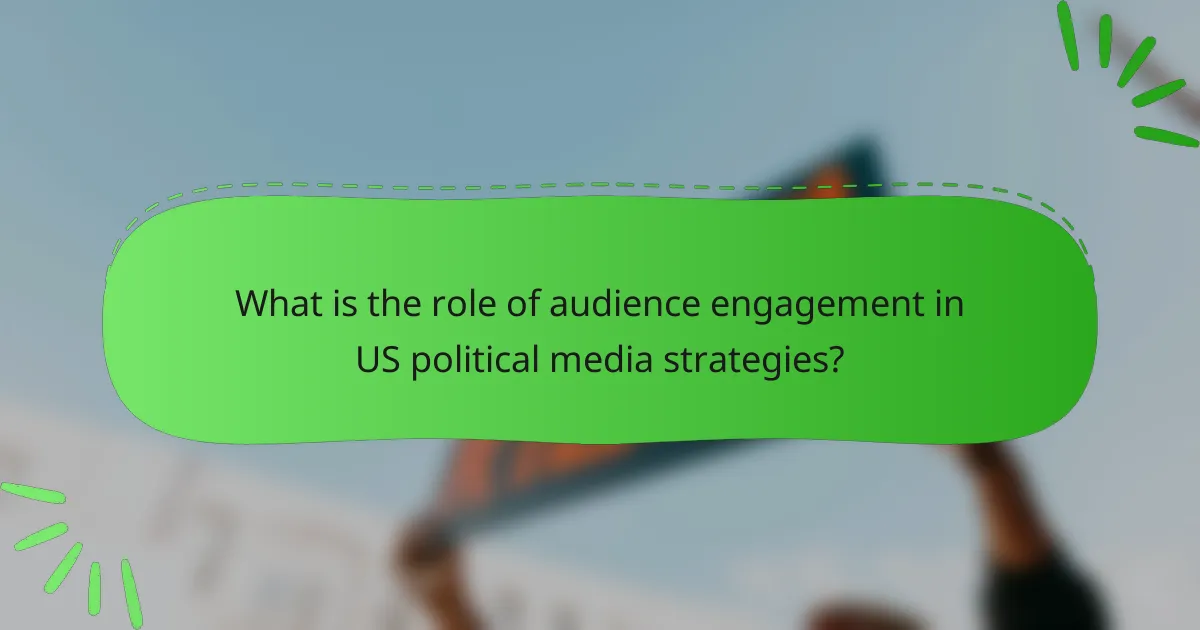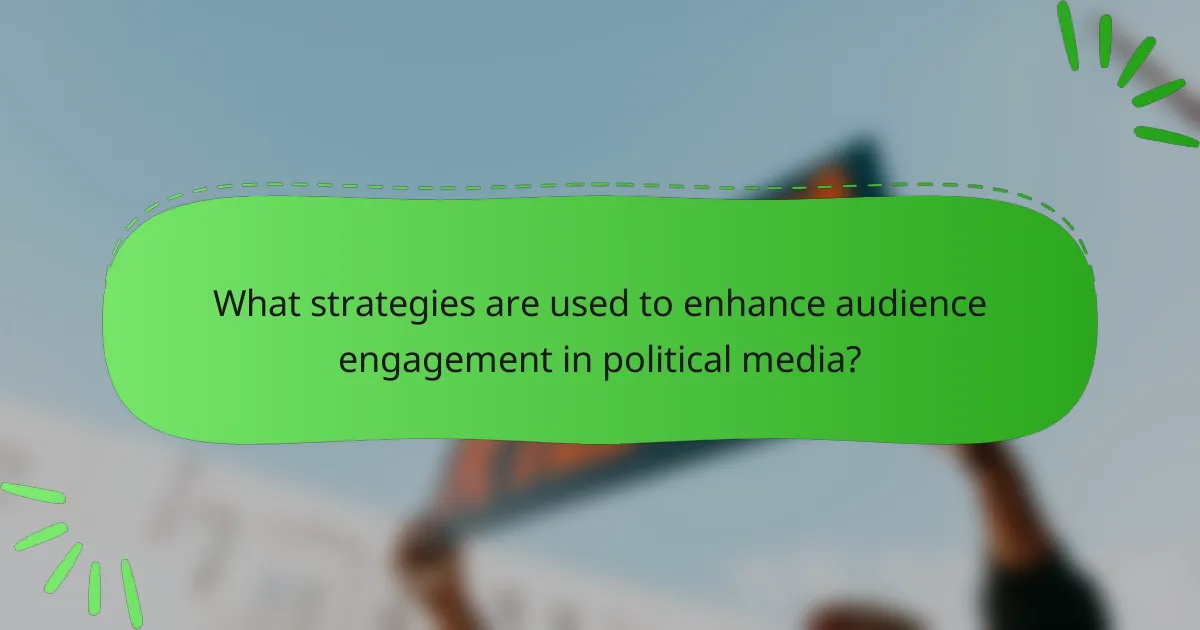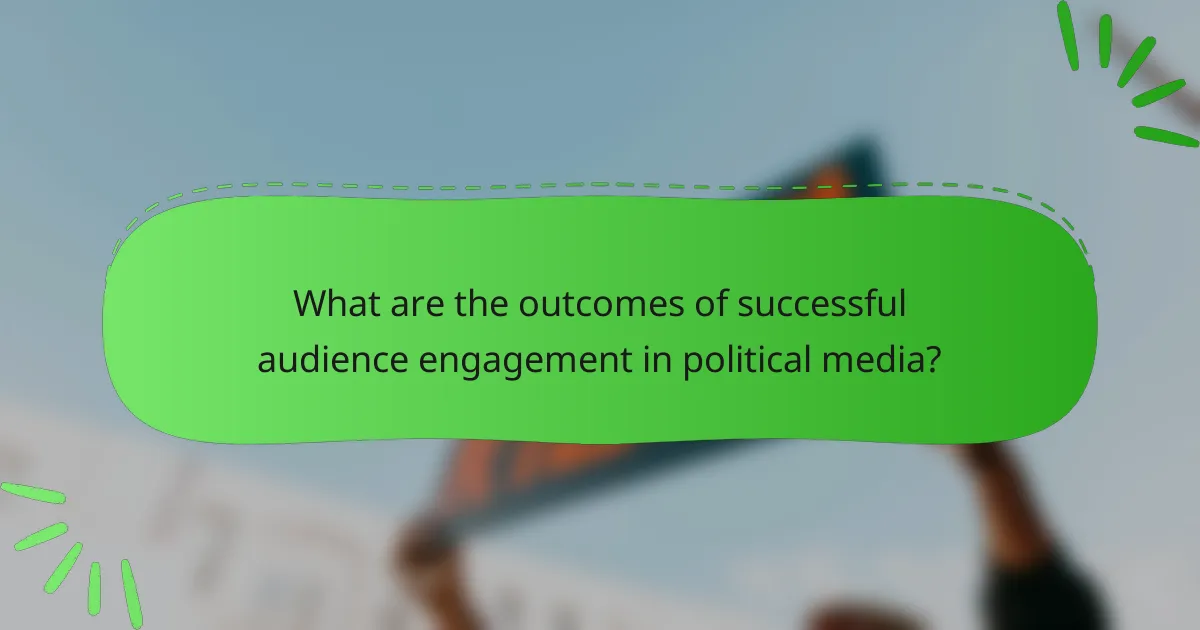Audience engagement is a critical element in US political media strategies, facilitating connections between politicians and their constituents. This engagement is essential for mobilizing support, shaping public opinion, and influencing political messaging and campaign tactics. Strategies such as interactive content, social media integration, and targeted messaging enhance audience participation and feedback, which can lead to increased voter turnout and greater political awareness. Research indicates that effective audience engagement can boost voter turnout by 10-20%, thereby contributing to a more informed electorate and a stronger democratic process. Engaged audiences play a vital role in holding politicians accountable and influencing political agendas.

What is the role of audience engagement in US political media strategies?
Audience engagement is crucial in US political media strategies. It fosters a connection between politicians and constituents. Engaging audiences helps in mobilizing support and shaping public opinion. Interactive platforms allow voters to express their views and concerns. This feedback loop influences political messaging and campaign tactics. Research shows that campaigns with high engagement rates see better voter turnout. For example, the 2020 presidential election highlighted the importance of social media engagement in reaching younger voters. Thus, audience engagement is a fundamental component of effective political communication strategies.
How does audience engagement influence political messaging?
Audience engagement significantly influences political messaging by shaping the content and delivery of messages. Engaged audiences provide feedback that helps political communicators understand public sentiment. This feedback loop allows for adjustments in messaging strategies to align with audience preferences. For example, social media interactions can reveal which issues resonate most with voters. A study by the Pew Research Center found that 69% of social media users believe these platforms help them engage with political issues. Additionally, higher engagement levels can lead to increased visibility and shareability of political messages. This dynamic interaction fosters a more responsive political discourse.
What are the key components of effective audience engagement?
Key components of effective audience engagement include understanding the audience, creating relevant content, fostering interaction, and measuring impact. Understanding the audience involves knowing their demographics, interests, and preferences. Relevant content is tailored to address the audience’s needs and concerns. Fostering interaction encourages dialogue through comments, social media shares, and live events. Measuring impact assesses engagement levels through analytics and feedback. Research shows that personalized communication increases audience involvement by 74% (Source: “The Importance of Audience Engagement,” MarketingProfs, authors: Ann Handley, Joe Pulizzi).
How does audience engagement shape public perception of political issues?
Audience engagement significantly shapes public perception of political issues. Engaged audiences actively participate in discussions and share opinions. This interaction influences how information is interpreted and prioritized. For example, social media platforms amplify voices that resonate with engaged users. Studies show that high engagement levels correlate with increased awareness of specific political topics. Furthermore, engagement can create echo chambers, reinforcing existing beliefs. Research indicates that 62% of Americans get news from social media, affecting their understanding of political issues. Thus, audience engagement plays a critical role in shaping perceptions through active participation and information dissemination.
Why is audience engagement critical in the context of political media?
Audience engagement is critical in political media because it fosters informed citizenry and drives democratic participation. Engaged audiences are more likely to consume, share, and discuss political content. This interaction amplifies the reach and influence of political messages. Studies show that higher engagement correlates with increased voter turnout. According to the Pew Research Center, engaged voters are 50% more likely to participate in elections. Additionally, audience feedback can shape political narratives and strategies. Politicians and media outlets that prioritize engagement can better address public concerns and adapt their messaging. This dynamic relationship enhances accountability and transparency in political discourse.
What historical examples illustrate the importance of audience engagement?
The Boston Tea Party in 1773 illustrates the importance of audience engagement in political movements. American colonists engaged their audience through public demonstrations. They effectively communicated their grievances against British taxation. This event galvanized public support and rallied colonists to the cause of independence.
Another example is President Franklin D. Roosevelt’s Fireside Chats. These radio broadcasts engaged the American public directly. Roosevelt addressed concerns during the Great Depression. His conversational tone fostered trust and connection with listeners. This approach increased public support for his New Deal policies.
The Civil Rights Movement also highlights audience engagement. Leaders like Martin Luther King Jr. used speeches and media to mobilize supporters. The March on Washington in 1963 showcased the power of collective action. It drew attention to racial injustice and engaged a diverse audience.
These historical examples demonstrate that effective audience engagement can mobilize support and drive significant political change.
How do different demographics respond to audience engagement strategies?
Different demographics respond uniquely to audience engagement strategies. Younger audiences prefer interactive and digital platforms. They engage more with social media campaigns and live-streamed events. Older demographics tend to favor traditional media channels. They respond well to email newsletters and televised town halls. Research shows that engagement strategies tailored to specific age groups enhance participation. For instance, a Pew Research study found that 72% of adults aged 18-29 engage with political content on social media. In contrast, only 39% of those aged 65 and older do the same. Additionally, ethnic diversity influences engagement preferences. Minority groups often seek representation in messaging. Tailored strategies that reflect cultural values increase their engagement levels. Overall, understanding demographic differences is crucial for effective audience engagement in political media strategies.

What strategies are used to enhance audience engagement in political media?
Strategies used to enhance audience engagement in political media include interactive content, social media integration, and targeted messaging. Interactive content, such as polls and quizzes, encourages audience participation. Social media integration allows for real-time feedback and discussion. Targeted messaging ensures that content resonates with specific demographics. Data shows that 60% of users engage more with interactive content. Additionally, social media platforms have billions of active users, making them effective for outreach. These strategies collectively foster a more involved and informed audience.
How do social media platforms facilitate audience engagement?
Social media platforms facilitate audience engagement by providing interactive features. These features include likes, comments, and shares that encourage user participation. Users can express opinions and connect with content creators directly. This interactivity fosters a sense of community among users. Additionally, algorithms prioritize engaging content, increasing visibility for posts that generate interaction. Research shows that posts with higher engagement receive more reach. A study by the Pew Research Center found that 69% of adults in the U.S. use social media, highlighting its role in communication. Overall, these elements create an environment conducive to active audience involvement.
What role does content creation play in engaging audiences?
Content creation plays a crucial role in engaging audiences by providing relevant and valuable information. It captures attention through storytelling and compelling visuals. Engaging content encourages interaction, fostering a sense of community among audiences. According to a study by HubSpot, 70% of marketers actively invest in content marketing to enhance audience engagement. Effective content also drives social sharing, increasing reach and visibility. The more audiences interact with content, the more likely they are to develop loyalty towards the brand or message. This loyalty is essential in political media strategies, as it can influence voter behavior and opinions.
How can political campaigns leverage data analytics for better engagement?
Political campaigns can leverage data analytics to enhance engagement by analyzing voter behavior and preferences. Campaigns can segment their audience based on demographics, interests, and past voting patterns. This targeted approach allows for personalized messaging that resonates with specific voter groups.
Data analytics also enables campaigns to track engagement metrics in real-time. By monitoring social media interactions and website traffic, campaigns can adjust their strategies promptly. For example, a study by Pew Research Center found that tailored content increases voter interaction by up to 30%.
Additionally, predictive analytics can forecast voter turnout and identify key issues that matter to constituents. This insight helps campaigns focus their resources effectively. Overall, utilizing data analytics leads to more informed decision-making and improved voter engagement.
What are the challenges faced in achieving effective audience engagement?
Challenges in achieving effective audience engagement include diverse audience preferences. Different demographics respond to varied content styles and platforms. Limited resources can hinder personalized communication strategies. Additionally, misinformation can erode trust and engagement. Competition for attention is intense in the digital landscape. Moreover, measuring engagement accurately remains complex. Changes in social media algorithms can impact visibility. Lastly, maintaining consistent interaction is often difficult. These factors collectively complicate the quest for meaningful audience engagement.
How do misinformation and disinformation impact audience engagement?
Misinformation and disinformation significantly reduce audience engagement. Misinformation refers to false or misleading information shared without harmful intent. Disinformation involves deliberate falsehoods aimed at manipulating public perception. Both can lead to confusion and distrust among audiences. Research shows that exposure to false information can decrease trust in media sources. A study by Lewandowsky et al. (2012) found that misinformation can lead to polarized opinions. This polarization diminishes constructive dialogue and reduces overall engagement. Furthermore, audiences may disengage from sources perceived as unreliable. Thus, misinformation and disinformation create barriers to meaningful audience interaction.
What ethical considerations must be addressed in audience engagement strategies?
Ethical considerations in audience engagement strategies include transparency, consent, and respect for privacy. Transparency requires clear communication about data usage and content sourcing. Consent involves obtaining permission from audiences before collecting personal information. Respect for privacy means safeguarding user data and ensuring it is not exploited. Additionally, avoiding manipulation and misinformation is crucial. Ethical engagement fosters trust and promotes informed participation. Research shows that ethical practices enhance audience loyalty and brand reputation.

What are the outcomes of successful audience engagement in political media?
Successful audience engagement in political media leads to increased voter turnout and greater political awareness. Engaged audiences are more likely to participate in elections. Studies show that voter turnout can increase by 10-20% with effective engagement strategies. Furthermore, audience engagement fosters informed discussions among citizens. This contributes to a more robust democratic process. Engaged audiences also influence political agendas and policy decisions. They hold politicians accountable through active participation. Overall, successful engagement enhances the effectiveness of political communication and strengthens democracy.
How does audience engagement affect voter turnout?
Audience engagement significantly increases voter turnout. Engaged audiences are more informed about issues and candidates. They are more likely to participate in elections. Research shows that mobilization efforts can raise turnout by 5% to 10%. Interactive platforms enhance engagement by facilitating discussions. Social media campaigns that encourage sharing can amplify reach. Studies indicate that personal outreach, such as phone calls, boosts participation rates. Engaged voters also tend to influence their peers, creating a ripple effect.
What metrics can be used to measure the success of audience engagement efforts?
Metrics to measure the success of audience engagement efforts include engagement rate, reach, and conversion rate. Engagement rate quantifies interactions such as likes, shares, and comments relative to total followers. Reach indicates the number of unique users who see the content, showcasing visibility. Conversion rate measures the percentage of users taking desired actions, like signing up or donating.
Additional metrics include click-through rate (CTR) and time spent on page. CTR assesses how many users click on links within content. Time spent on page reflects user interest and content effectiveness. Audience sentiment analysis can also provide insight into the emotional response to content.
According to a study by the Pew Research Center, higher engagement rates correlate with increased political awareness and participation among audiences. This data supports the importance of tracking these metrics for effective audience engagement in political media strategies.
What best practices can enhance audience engagement in political media strategies?
Utilizing interactive content enhances audience engagement in political media strategies. Interactive elements like polls, quizzes, and live Q&A sessions invite participation. These formats encourage users to share opinions and feel involved. Research shows that interactive content can increase user retention by 80%. Additionally, personalization of content based on user preferences fosters a deeper connection. Tailored messaging resonates more, leading to higher engagement rates. Consistent communication across multiple platforms amplifies reach and maintains audience interest. Engaging storytelling also captivates viewers, making political messages more relatable and memorable.
How can political organizations tailor their engagement strategies for different audiences?
Political organizations can tailor their engagement strategies for different audiences by identifying specific audience segments. These segments can include demographics such as age, gender, location, and political affiliation. Understanding the values and interests of each segment is crucial. Political organizations should customize their messaging to resonate with these values. For example, younger audiences may prefer digital platforms and social media engagement. In contrast, older audiences might respond better to traditional media like television or print.
Using data analytics can enhance the understanding of audience behavior and preferences. Political organizations can track engagement metrics to refine their strategies continuously. Personalized communication, such as targeted emails or social media ads, can increase the effectiveness of outreach efforts. Research shows that tailored messaging can significantly improve voter engagement and mobilization. For instance, a study by the Pew Research Center found that personalized content leads to higher interaction rates among targeted groups.
What innovative approaches can be adopted to improve audience interaction?
Utilizing interactive technologies such as live polling can significantly enhance audience interaction. This method allows real-time feedback and engagement during events or broadcasts. Incorporating social media platforms for discussions fosters community and dialogue among viewers. Additionally, gamification elements can make participation more enjoyable and rewarding. Offering exclusive content or behind-the-scenes access encourages deeper connections with the audience. Personalized communication through targeted messaging can also increase engagement by making the audience feel valued. Research shows that these strategies lead to higher audience retention and satisfaction. According to a study by the Pew Research Center, 64% of participants reported greater interest in content that involved interactive elements.
The main entity of this article is audience engagement in US political media strategies. The article outlines the critical role of audience engagement in fostering connections between politicians and constituents, mobilizing support, and shaping public opinion. It discusses how engagement influences political messaging, highlights key components for effective engagement, and examines the impact of different demographics on engagement strategies. Additionally, it explores historical examples, challenges, and best practices in audience engagement while emphasizing the importance of data analytics and ethical considerations in enhancing political communication.